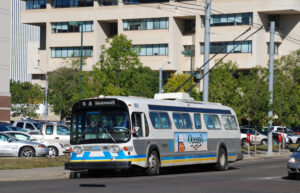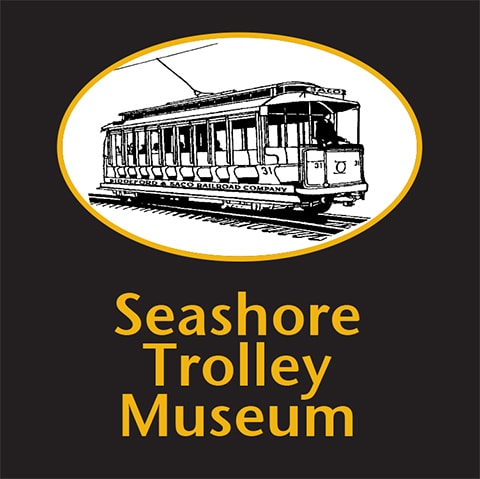
Edmonton trolleybus 192, built in 1982 by Brown Boveri (using a GM body & chassis), on 97th Street at 102nd Avenue, on route 135.
Operating History: The transit system in Edmonton, Alberta, Canada began to replace streetcars with trolley buses in 1939. These vehicles can also be termed “trackless trolleys” or “trolley coaches.” Trolley buses have some advantages as transit vehicles. They can accelerate and brake better than motor buses, and they have no exhaust and are almost silent. They are the best transit vehicles (aside from cable cars) for climbing and descending steep hills. A downside for trolley buses is their two overhead wires (thought by some to be unsightly) which are required to complete the electric circuit unlike streetcars which use rails for the return current. More importantly, until the 1990s, trolley buses were restricted to streets with the overhead wires. Since then, all newly manufactured trolley buses are equipped with auxiliary battery power which allows them to bypass streets undergoing construction and to extend service beyond the end point of the overhead wires. In the 1950s and 1960s, most North American transit operators replaced trolley bus routes with more versatile motor buses.
The last Edmonton streetcar ran in 1951. In common with other Canadian cities, Edmonton had a large trolley bus network which, at its peak, had 79 route miles. In 1981-82, the city-owned Edmonton Transit System replaced its older trolley buses with a fleet of 100 new trolley buses, Nos. 100-199. These vehicles consisted of bodies built by General Motors Diesel Division and electrical components by the Swiss firm, Brown Boveri & Company. Edmonton Nos. 100-199 were the only trolley buses built by General Motors, although Yellow Coach, which was a division of GM, built many trolley buses in the 1930s. GM’s Edmonton trolley buses used the same “New Look” (unofficially, also termed “Fishbowl”) body that GM used on over 44,000 motor buses. GM built “New Look” buses from 1959 to 1977 in the United States and until 1985 in Canada. The design featured a rounded windshield and a lightweight, aluminum skin.
Edmonton Transit System put No. 125 in storage in 1998 and returned it to service in 2004. In June 2008, the city council voted to end its trolley bus operation, and, the next month, No. 125 was placed back in storage. The last trolley bus ran on May 2, 2009, leaving Vancouver as the only Canadian city still using trolley buses. Diesel buses then provided most of Edmonton’s transit service. The city had also started a modern, light rail operation in 1978 which was expanded in 1983 and in more recent decades. More recently, the city has returned to electric-powered buses but without the overhead wires. Edmonton is now operating some hybrid buses as well as all-electric, battery-powered buses.
Museum Ownership: Edmonton Transit System donated No. 125 to Seashore. It arrived at the museum in 2010. No. 125 became part of the museum’s extensive collection of Canadian transit vehicles – the largest outside of Canada. Several other Edmonton “New Look” trolley buses are preserved elsewhere, including some in the Edmonton Transit Service (renamed from “System” in 2016) historic vehicle fleet.
Current Condition: As of October 2021, No. 125 is stored in the museum parking lot near Northampton Station. It appears to be in good condition.
 |
 |
 |
